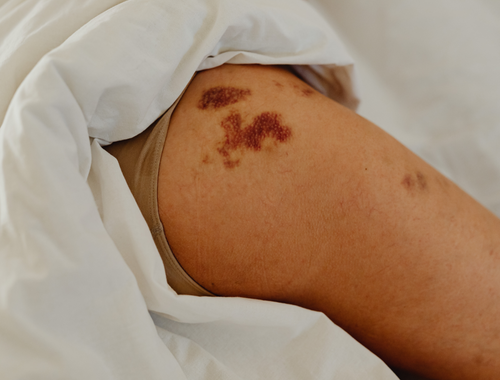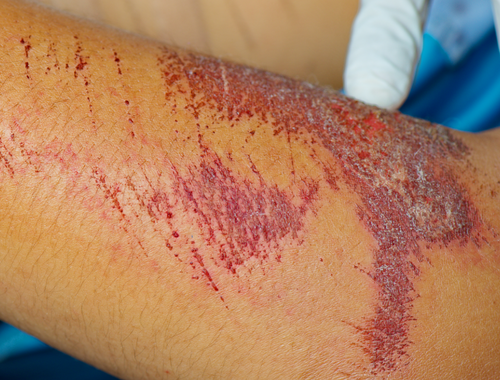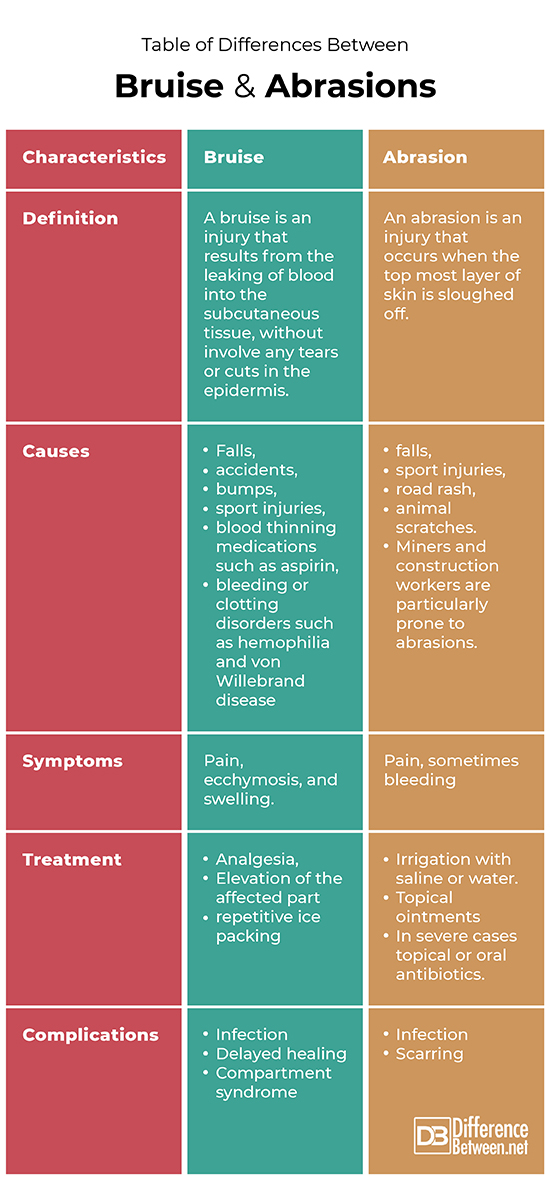Difference Between Bruise and Abrasion
A bruise, also referred to as a contusion, is the trauma induced disruption of the capillaries, causing the blood to leak into the adjacent tissues. It will remain prominent until the immune cells clear up the blood or the tissues soak the blood completely. An abrasion is a frictional injury that results in the superficial skin layers to be scrapped off. It does not always cause bleeding.

What is a Bruise?
Definition:
A bruise is a discoloration that is associated with subcutaneous hemorrhage and laceration without the presence of an obvious wound at the affected site.
Causes:
Bruising is a normal phenomenon. Falls, accidents, bumps and sport injuries are few of the common causes of harmless bruises. However increased propensity to bruising is alarming and needs evaluation to determine the exact cause. Familial medical conditions such as hemophilia and Von Willebrand disease can result in frequent bruising. Other causes include taking blood thinning medications such as aspirin, having a low platelet count and having a deficiency of Vitamin C or K. One key differential diagnosis of bruising is child abuse which should never be neglected.
Diagnosis:
A physician will observe and diagnose a bruise based on its discrete look. Unexplained frequent bruising might need additional tests such as blood tests and X-rays.
Symptoms:
The clinical signs and symptoms of bruising range from pain initially depending on the extent and site of injury, followed by ecchymosis, and lastly swelling. Color changes of the wound are common. The bruise is initially red and purple and may appear black on darker skin tones. With healing it transitions to lighter brown and yellow. Very severe contusions will result in a blood filled, boggy mass called hematoma.
Treatment:
The key objective of treating bruise is to promptly control the extravasation of the blood. This is done by giving analgesia and by rest and elevation of the affected part. Ice packs are applied repetitively for the first 48 hours. Warm compresses are used after 2 days. Majority of the bruises fade away in two weeks with good conservative management. Hematomas, however take a month or more to subside.
Complications:
Infection is one of the leading complications of bruises. Bacteria can penetrate through the broken skin causing redness, warmth, and pain of the adjacent tissues. Antibiotics might be required to treat the condition. Delayed healing is another complication of bruises, particularly those which are large. In rare cases, the deep penetrating bruise can cut off the blood and nerve supply of the muscles resulting in Compartment syndrome. In such cases, urgent fasciotomy is required to salvage the tissues.

What is an Abrasion?
Abrasions are frequently encountered in minor accidents. In these injuries, the top skin layer is sloughed off however the bleeding may or may not be present. Abrasions are quite common on the bony prominences of knees, elbows, and face.
Causes:
Abrasions, also referred to as scrapes or scratches, are caused by rubbing against a rough surface. Some common causes of abrasions include falls, sport injuries, road rash, and work-related injuries. Falling on dirt and rough, gravel surfaces can cause cuts in the epidermis of the skin. Motorbike and bicycle accidents frequently cause abrasions to the riders. Some occupations such as miners, plumbers and construction workers are particularly prone to abrasion injuries as their work involves contact with sharp rough surfaces. Abrasions can also be caused by animal bites or scratches. Attempts to self-harm, such as cutting or slitting the skin can also cause abrasions.
Diagnosis:
The diagnosis of abrasions is usually a straightforward process and involves majorly the physical examination of the affected area. It involves the assessment of the depth and size of the wound, and any signs of local damage of adjacent tissue. Sometimes fractures co-exist with abrasions for which additional tests such as Xray is requested.
Symptoms:
Abrasion presents as a red, painful patch on the skin. It is pink in color, may be oozing fluid and in rare cases bleeding.
Treatment:
Abrasions are typically small and simple wounds in nature. The first step to treatment of abrasion is irrigation of the area with water or saline. Most abrasions heal swiftly. Due to the loss of the epidermis, abrasions are particularly susceptible to bacterial infection. Tetanus toxoid status of the person should be evaluated and if needed a booster shot should be given. If abrasions are large, debridement and systemic antibiotics might be required.
Complications:
Wound infection and scarring are few of the common complications of abrasions.
Difference between bruise and abrasion:
Definition:
A bruise is an injury that results from the leaking of blood into the subcutaneous tissue, without involve any tears or cuts in the epidermis. An abrasion is an injury that occurs when the top most layer of skin is sloughed off.
Causes:
Causes of bruises include falls, accidents, bumps, and sport injuries, taking blood thinning medications such as aspirin, and bleeding or clotting disorders. Causes of abrasions include falls, sport injuries, road rash, and animal scratches. Miners and construction workers are particularly prone to abrasions.
Symptoms:
Symptoms of bruises include, pain, ecchymosis, and swelling. Symptoms of abrasions include painful red patch on the skin.
Diagnosis:
Diagnosis of both the conditions is through physical examination.
Treatment:
Bruises are managed by giving analgesia, elevating the affected part and repetitive ice packing. Abrasions need irrigation with saline or water, topical ointments and in severe cases topical or oral antibiotics.
Complications:
Infection, delayed healing and compartment syndrome are few of the complications of bruises. Complications of abrasions include wound infection and scarring.
Table of differences between bruise and abrasions:

FAQs:
What is the difference between a bruise and a wound?
Bruise is the bleeding into the skin without scraping off the superficial layer of skin or without any cuts. Wound is a catch-all term for most injuries such as cuts, lacerations, and bruises.
What does an abrasion look like?
a typical abrasion will look like a scraped off piece of skin. The injured area will be painful, tender, pink in color and sometimes bleeding or oozing discharge.
What is an example of an abrasion?
A scrapped knee is an example of an abrasion.
What is the difference between contusion and laceration?
Contusion is a wound that has intact skin, with bleeding beneath it whereas lacerations is deep irregular wound or tear of the skin
What is the difference between laceration and abrasion?
While both are the discontinuities in the skin, abrasions rarely cause bleeding whereas lacerations almost always are bleeding.
What is the difference between abrasion and contusion?
Contusion or bruise is the subcutaneous hemorrhage after a blow or fall injury. Abrasion is scrapped off superficial skin without bleeding.
Does abrasion mean Bruise?
No. Bruise is discolored skin secondary to subcutaneous bleeding after an injury. Abrasion is sloughed off superficial skin after an injury which may or may not be bleeding.
How do you tell if it is a bruise?
A bruise will have a discoloration on the site of injury. It would be painful and not bleeding in nature.
What wound stage is a bruise?
The very first stage of a wound is a bruise.
What can be mistaken for a bruise?
Petechiae and purpura in bleeding and clotting disorders can be mistaken for a bruise.
Do bruises hurt more as they heal?
Bruises get less painful as they heal.
- Differences Between Reptiles and Amphibians - May 17, 2024
- Difference Between Ophthalmology and Optometry - May 15, 2024
- Difference Between Fear and Anxiety - April 2, 2024
Search DifferenceBetween.net :
Leave a Response
References :
[0]Heinemann, Lutz. “Bruising-An Ignored Issue?.” Journal of diabetes science and technology vol. 16,4 (2022): 799-803.
[1]Love, R J. “ABRASIONS AND CONTUSIONS.” British medical journal vol. 1,4018 (1938): 82-4.
[2]Shrestha, Rijen, Kewal Krishan, and Tanuj Kanchan. "Abrasion." (2020).
